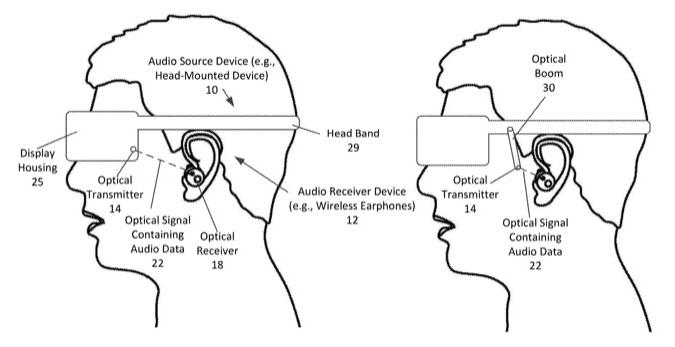A newly-granted Apple patent suggests that the company may be planning to use optical audio transmission from AR/VR headsets to AirPods.
The patent could align with recent comments made by Apple’s head of acoustics about the limitations of Bluetooth bandwidth…
Background
Gary Geaves’ interview with What HiFi did not directly address headsets, but it did talk about spatial audio, which would also be relevant to augmented reality (AR)/virtual reality (VR) headsets.
“Obviously the wireless technology is critical for the content delivery that you talk about”, he says, “but also things like the amount of latency you get when you move your head, and if that’s too long, between you moving your head and the sound changing or remaining static, it will make you feel quite ill, so we have to concentrate very hard on squeezing the most that we can out of the Bluetooth technology, and there’s a number of tricks we can play to maximise or get around some of the limits of Bluetooth. But it’s fair to say that we would like more bandwidth and… I’ll stop right there. We would like more bandwidth,” he smiles.
One way of getting more bandwidth would be to use optical audio transmission. For hifi setups, this is typically done using an optical cable, but it can also be done wirelessly. Wireless optical signals are easily blocked, making them most suitable for very short distances, and it’s this scenario that Apple describes in its patent.
Optical audio transmission patent
Apple’s patent (spotted by Patently Apple) is of course written in the usual generic terms.
A system that includes an audio source device configured to obtain audio data of at least one audio channel of a piece of program content. The audio source device has an optical transmitter for transmitting the audio data as an optical signal and a radio frequency (RF) transceiver. The system also includes a wireless earphone that has an optical receiver for receiving the audio data as the optical signal, a RF transceiver for transmitting feedback data indicating a reception quality of the received optical signal at the wireless earphone as a wireless RF signal, and a speaker for outputting the audio data contained within the optical signal and/or the data packets as sound.
However, one of Apple’s illustrations makes no secret of the fact that the company is considering it to send wireless optical audio from a headset to a pair of in-ear AirPods.

Even over such a short distance, there could be challenges in using optical transmission – which is by definition line-of-sight – to in-ear headphones. That’s why Apple’s patent describes a radio signal (Bluetooth) as well. The Bluetooth signal would be used to tell the AirPods the signal they should have received, and for the AirPods to send back what they actually received. The likelihood is that Bluetooth audio would then be a fallback if optical audio failed.
We’re currently expecting Apple to launch a relatively large and expensive AR/VR headset first, while working its way toward an eventual sleeker Apple Glasses product, which the company even thinks might eventually replace the iPhone.
Our usual patent disclaimer of course applies: Apple patents a great many more things than ever make it into products.
FTC: We use income earning auto affiliate links. More.




